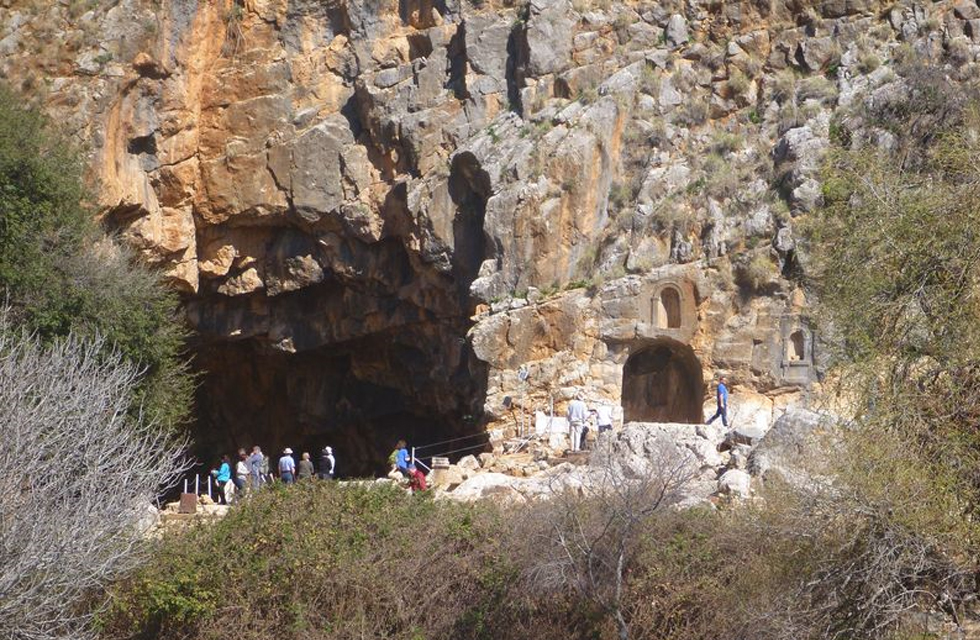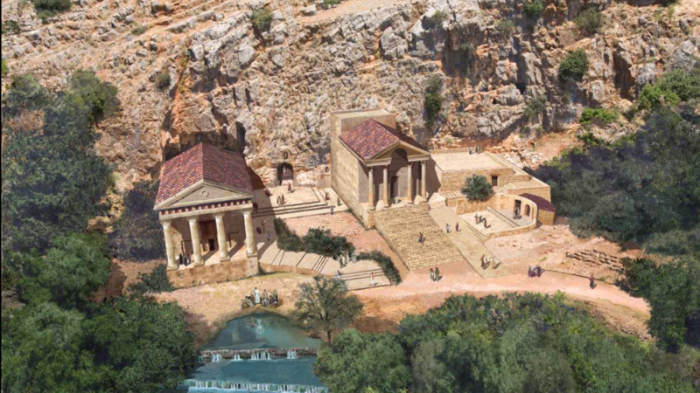Caesarea Philippi

We left the Tel Dan Nature Reserve sometime in the mid-morning and headed about 4 miles to the east, to the area that was known in the first century as Caesarea Philippi. You can see it roughly in the upper right on the map below.

(Map courtesy of Bible-History.com)
I have to admit that I didn’t know anything about Caesarea Philippi prior to this trip. Sure, I’d read the scripture and knew that Jesus had come to this region with his disciples,and that it was here that he asked them a very important question:
Now when Jesus came into the district of Caesarea Philippi, he asked his disciples, “Who do people say that the Son of Man is?” (Matthew 16:13)
What I was about to learn was that I’d been pretty ignorant as to the significance of that particular question, in that particular location. I’m no theologian, but here are a few thoughts to ponder:
- Caesarea Philippi was associated with pagan worship, prior to – and during – Jesus’ day. It’s probably not a stretch to say that this was the most pagan place in all of Palestine.
- Historians have associated this area with at least 14 temples connected to ancient Syrian Baal worship.
- I mentioned in my previous post that the Israeli king Jeroboam practiced idol worship in the city of Dan, only four miles from this site.
- Coming later, in the Hellenistic period, this area was known as a sanctuary to the Greek god Pan, with the Cave of Pan being a most sacred pagan site. The cave contained a deep, almost bottomless spring, which fascinated the ancients with its mystery. Our guide Kenny described some of the pagan rituals that occurred here at the Cave of Pan. We could still see 5 niches carved out of the stone next to the cave, which would have probably contained pagan statues. The cave and the niches were known at the time as the “rock of the gods”.
- The cave at Caesarea Philippi is one of four sources of the Jordan River, a fact which would have been cause for deep reverence to the first century Jews.
- There was a temple at Caesarea Philippi dedicated to the “godhead” of Caesar, built by Herod the Great sometime after 20 BC.
- In Jesus’ day, Caesarea Philippi, and specifically the Cave of Pan, was known as “The Gates of Hades”, since it was believed that pagan gods came and went to the underworld through bodies of water, such as the deep pool in the Cave of Pan.
It was here, in this place so steeped in ancient paganism, that Jesus brought his disciples to ask them, “Who do people say that the Son of Man is?”
Why here? This wasn’t exactly in their neighborhood. It would have been a roughly 25 mile journey for them, from the northern shore of Galilee. And to be there at all would have been considered a defilement to a devout Jew. So, why here?
I love how it was expressed by David Padfield:
“Jesus was standing on a road in an area littered with the temples of the Syrian gods, a place where the Greek gods looked down, a place where the most important river in Judaism sprang to life, a place where the white marble splendor of the home of Caesar-worship dominated the landscape. And here, of all places, He stands and asks men who they believe Him to be. Peter boldly answers that He is “the Christ, the Son of the living God” (Matt. 16:16)… it is as if Jesus deliberately set Himself against the background of the world’s religions in all their splendor and glory and demanded to be compared with them.”
I love Jesus. He takes His disciples on a road trip to the first century equivalent of Las Vegas, and compels them to make a choice about Him.
Now when Jesus came into the district of Caesarea Philippi, he asked his disciples, “Who do people say that the Son of Man is?” And they said, “Some say John the Baptist, others say Elijah, and others Jeremiah or one of the prophets.”
He said to them, “But who do you say that I am?” (Matthew 16:13-15)
I can almost envision Him, slowly looking each disciple in the eye, making this a very personal question indeed. No shallow answer would do this time. Jesus wanted to know what was in their hearts. Not surprisingly, it is Peter who steps up to the plate:
Simon Peter replied, “You are the Christ, the Son of the living God.” (Matthew 16:16)
I love the fullness of Peter’s answer. All or nothing.
And Jesus answered him, “Blessed are you, Simon Bar-Jonah! For flesh and blood has not revealed this to you, but my Father who is in heaven. And I tell you, you are Peter, and on this rock I will build my church, and the gates of hell shall not prevail against it. (Matthew 16:17-18)
I never realized before this trip that “the Gates of Hell” was actually a reference to a literal place – albeit a literal place that would have been full of meaning to the disciples, or to any first century Palestinian. I realize that there are many interpretations of these passages, but it seems to me that Jesus was telling them that He would prevail against Satan, period. He would take the fight to the darkest places on the planet, and that the gates of hell would not – and can not – hold Him back.
Lots of food for thought.
The cave of Pan today:

Niches carved around the cave:

Reconstruction of the site, courtesy of the bible software GloBible:




Recent Comments